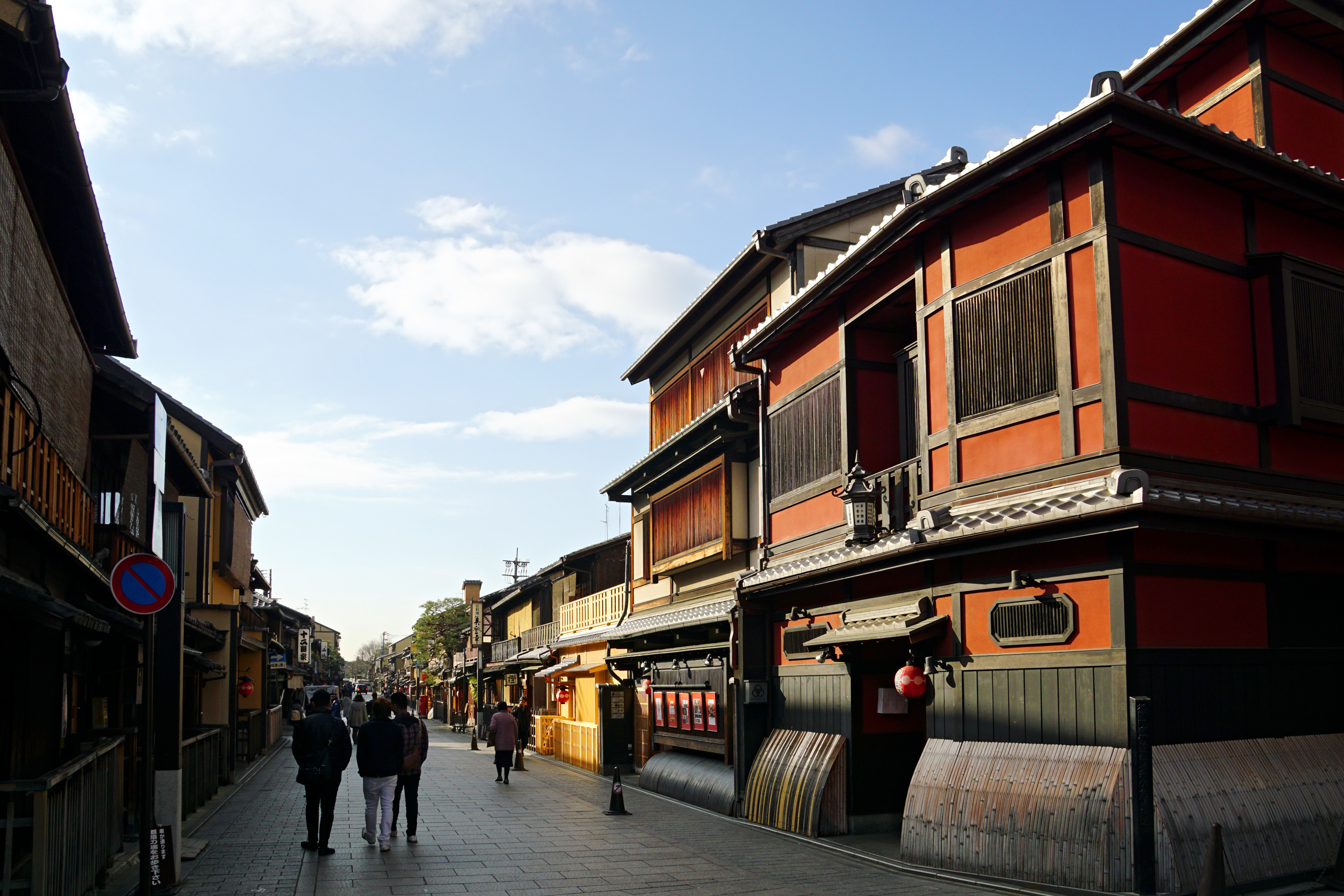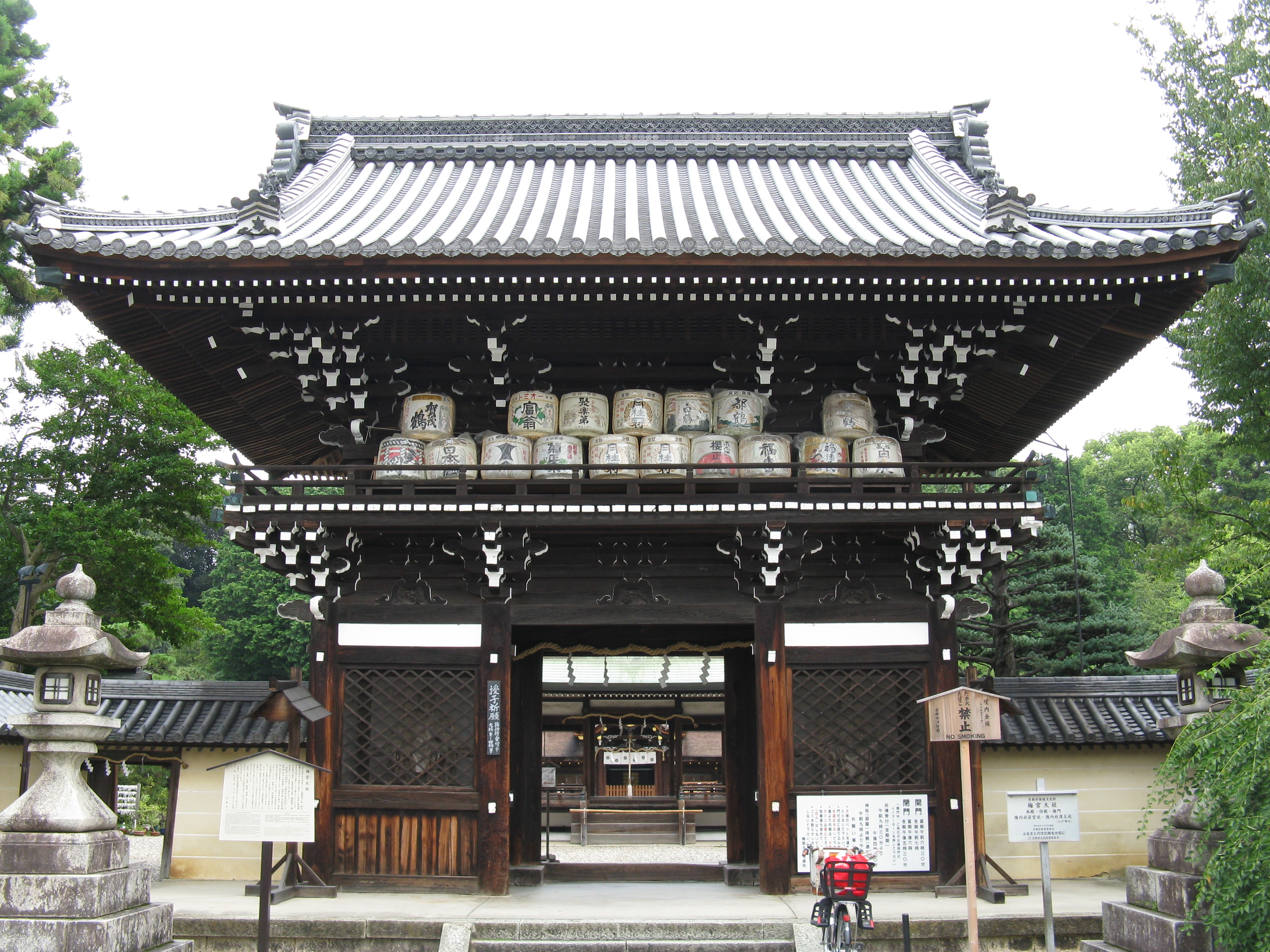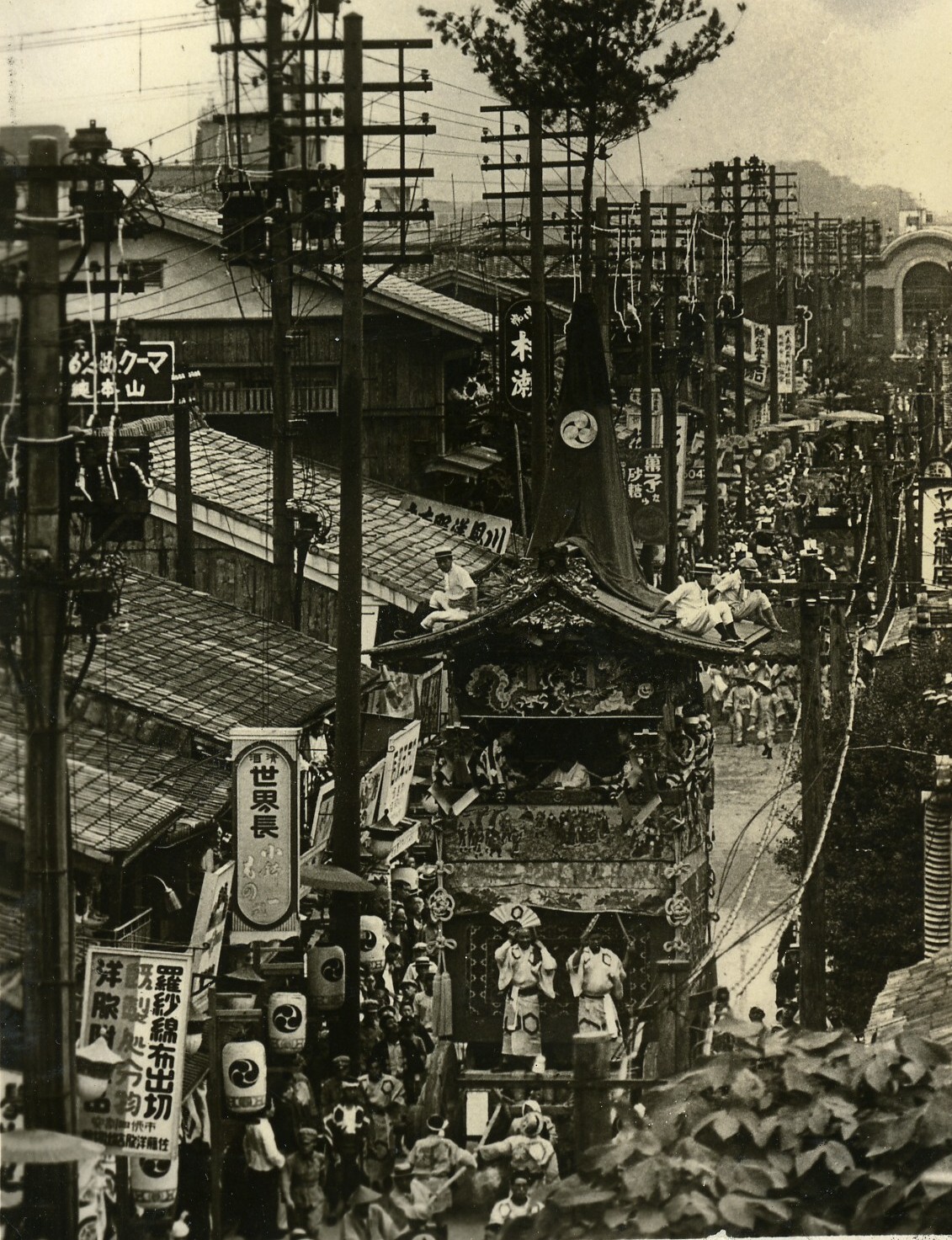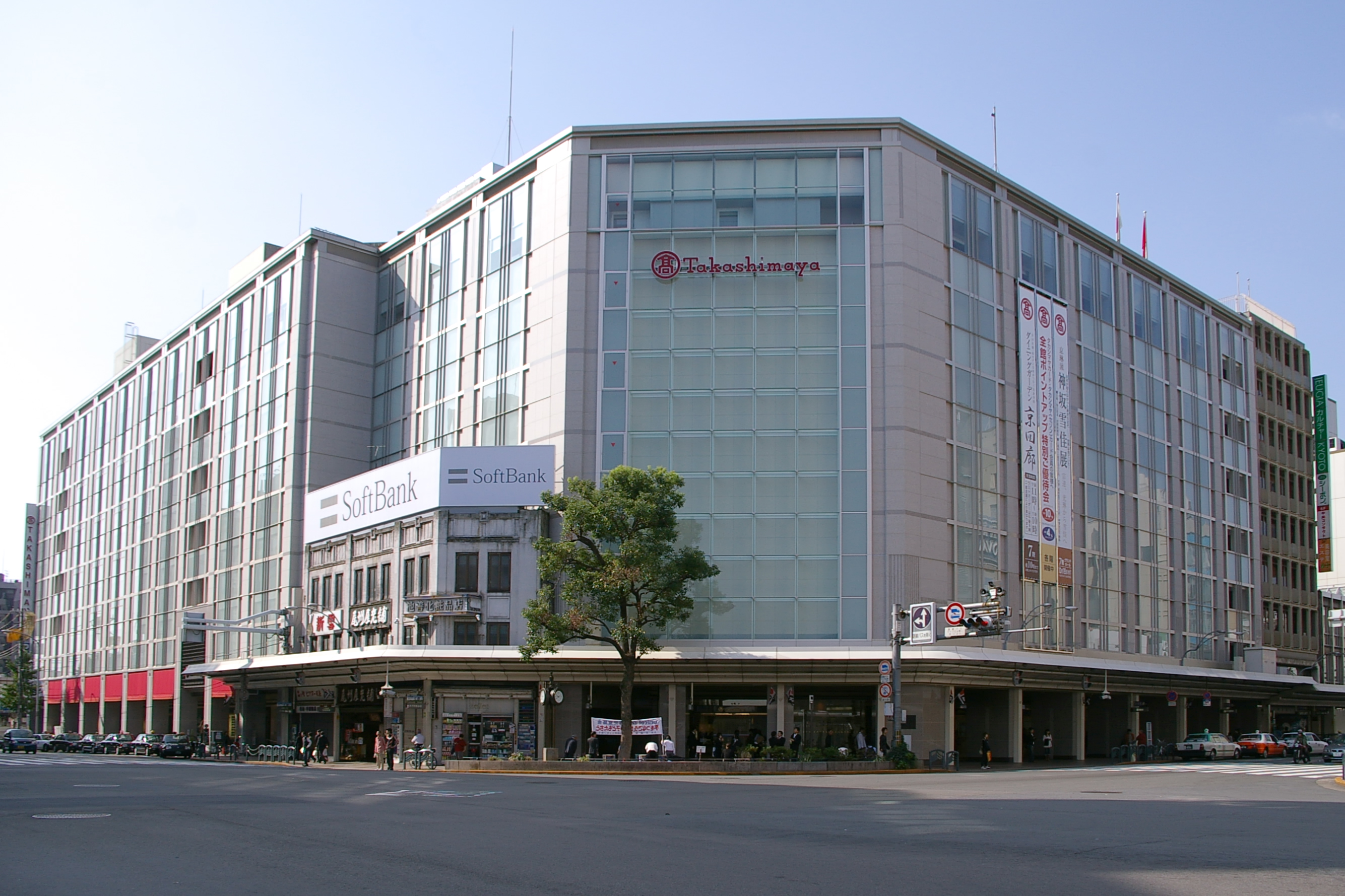|
Shijō Street
runs in the center of Kyoto, Japan from east to west through the commercial center of the city. Shijō literally means ''Fourth Avenue'' of Heian-kyō, the ancient capital. History The section between Shinkyōgoku street and the vicinity of the east side of the Tenjingawa river corresponds to the Shijō Ōji Avenue(四条大路)of the Heian-kyō. After the road was widened in 1911, it developed as an important traffic artery. The Shijō school of art derives its name from this street, since many artists were located there. Along the street The eastern end of the street is Yasaka Shrine and the western end is Matsunoo Shrine. The street is particularly busy with pedestrians and traffic from the east end to Karasuma Street. The east end passes through the courtesan's district of Gion, with the historic street of Hanami Lane branching off to the south, with the famous Ichiriki Chaya at the corner. It then crosses the Kamo River at Shijō Bridge, and from there to Ka ... [...More Info...] [...Related Items...] OR: [Wikipedia] [Google] [Baidu] |
Higashiyama-ku, Kyoto
is one of the eleven wards in the city of Kyoto, in Kyoto Prefecture, Japan. History It was created in 1929 when it was split off from Shimogyō-ku. During the years 1931 to 1976 it also covered the area of present-day Yamashina-ku, which was an independent town until its merger into the city in 1931. The name literally means "Eastern Mountain District". Due to the restrictions against urban development, the population inside the ward is continually decreasing. Higashiyama-ku has the lowest population of all the wards in Kyoto, and a disproportionate number of elderly people. Geography Interposed between the Kamo River and the Higashiyama mountain range, Higashiyama-ku is roughly bounded by the Sanjō street in the north, and the Jūjō street in the south. Historically, this area lay outside the official boundaries of the city of Kyoto. The western part consists mainly of residential areas, whereas the eastern part is covered by forests. In the north, between the Kamo ... [...More Info...] [...Related Items...] OR: [Wikipedia] [Google] [Baidu] |
Gion
is a district of Higashiyama-ku, Kyoto, Japan, originating as an entertainment district in the Sengoku period, in front of Yasaka Shrine (Gion Shrine). The district was built to accommodate the needs of travellers and visitors to the shrine. It eventually evolved to become one of the most exclusive and well-known geisha districts in all of Japan. Gion is the Japanese translation (via Chinese ''Qiyuan'') of the Buddhist term Jetavana. The geisha in Kyoto do not refer to themselves as geisha, instead using the local term . While the term geisha means "artist" or "person of the arts", the more direct term means essentially "a woman of art". Divisions Gion houses two , or geisha districts: and . The two were originally the same district, but split many years ago. Gion Kobu is larger, occupying most of the district including the famous street Hanamikoji, while Gion Higashi is smaller and occupies the northeast corner, centered on its rehearsal hall. Despite the considerable d ... [...More Info...] [...Related Items...] OR: [Wikipedia] [Google] [Baidu] |
Kyoto Municipal Transportation Bureau
is an agency of the city government of Kyoto, Japan that operates municipal subways and city buses within the city. Previously, it also operated trams and trolley buses. Subway The Kyoto Municipal Subway operates the following two lines: *Karasuma Line * Tōzai Line Bus The are major mean of public transport in Kyoto. The buses have been operating since 1928. Besides the regular commuter routes, the city bus co-operated the city's "Regular Tour Bus" with Keihan Bus. Tram Kyoto Municipal Transportation Bureau operated the until 1978. Kyoto Electric Railway ( narrow gauge) opened in 1895 as the first electric streetcar in Japan in commercial operation. The city government launched separate network of streetcars of in 1912, which absorbed the lines of Kyoto Electric Railway in 1918. Subsequently, the narrow gauge lines were closed, rebuilt in standard gauge, or remained as is (Kitano Line). In its peak of the 1960s, the network was as follows: *Loop line **Gaishū Line (L ... [...More Info...] [...Related Items...] OR: [Wikipedia] [Google] [Baidu] |
Katsura River
The is a continuation of two other rivers, the Hozu River, a small, speedy river which begins in the mountains near Kameoka and then slithers through the mountains separating Kameoka and Kyoto; and the Ōi River (大堰川 ''Ōi-gawa''), which emerges from those mountains and expands into a shallow, slow-flowing river until Togetsukyo Bridge in Arashiyama. From that point forward, the river is referred to as the Katsura River, and its flow continues for several kilometers through Kyoto Prefecture until it joins the Kamo and Uji rivers. The Katsura River area features some of the oldest shrines in Kyoto and Japan, such as Matsuo Shrine, and, as a counterpoint to the channelled Kamo River, supports acres of agricultural area on its flood plain. It also is known for its summer supply of '' ayu'' and is a popular place for holding barbecues. See also * Katsura, Kyoto Katsura (桂) is a neighborhood in Nishikyo-ku, in the western part of the city of Kyoto, Japan. Predominant ... [...More Info...] [...Related Items...] OR: [Wikipedia] [Google] [Baidu] |
Umenomiya Shrine
is a Shinto shrine located in Ukyō-ku in Kyoto, Japan. History The shrine became the object of Imperial patronage during the early Heian period. In 965, Emperor Murakami ordered that Imperial messengers were sent to report important events to the guardian ''kami'' of Japan. These ''heihaku'' were initially presented to 16 shrines; and in 991, Emperor Ichijō added three more shrines to Murakami's list. Three years later in 994, Ichijō refined the scope of that composite list by adding and Gion Shrine, which is now known as Yasaka Jinja.Ponsonby-Fane, ''Shrines,'' p. 118. From 1871 through 1946, the Umenomiya Shrine was officially designated one of the , meaning that it stood in the second rank of government supported shrines.Ponsonby-Fane, Richard. (1959). ''The Imperial House of Japan,'' pp. 126. See also * List of Shinto shrines * Twenty-Two Shrines * Modern system of ranked Shinto Shrines Notes References * Breen, John and Mark Teeuwen. (2000) ''Shinto in History: ... [...More Info...] [...Related Items...] OR: [Wikipedia] [Google] [Baidu] |
Minami-za
is the primary kabuki theatre in Kyoto, Japan. It was founded in 1610 as . The current building, with a 1,086 seat capacity, was built in 1929. History The Minami-za is one of the earliest of the seven officially-licensed kabuki theatres built in the early Edo period (1615-1623) in the Shijo Kawara area in Kyoto; the theatre pre-dates those of Tokyo and Osaka. The current Minami-za theatre was built in 1929 in the architectural style of the Momoyama period, with a gabled roof and a traditional turret marking the official approval of the government. In 1991, after the end of the Shōwa period Shōwa may refer to: * Hirohito (1901–1989), the 124th Emperor of Japan, known posthumously as Emperor Shōwa * Showa Corporation, a Japanese suspension and shock manufacturer, affiliated with the Honda keiretsu Japanese eras * Jōwa (Heian ..., the interior was drastically refurbished and modern stage mechanism was installed. In 1996, the Minami-za was registered as a Japanese Tan ... [...More Info...] [...Related Items...] OR: [Wikipedia] [Google] [Baidu] |
Gion Matsuri
The is one of the largest and most famous festivals in Japan, taking place annually during the month of July in Kyoto. Many events take place in central Kyoto and at the Yasaka Shrine, the festival's patron shrine, located in Kyoto's famous Gion district, which gives the festival its name. It is formally a Shinto festival, and its original purposes were purification and pacification of disease-causing entities. There are many ceremonies held during the festival, but it is best known for its two processions of floats, which take place on July 17 and 24. The three nights leading up to each day of a procession are sequentially called , , and . During these evenings, Kyoto's downtown area is reserved for pedestrian traffic, and some traditional private houses near the floats open their entryways to the public, exhibiting family heirlooms in a custom known as the . Additionally, the streets are lined with night stalls selling food such as (barbecued chicken on skewers), , (fried o ... [...More Info...] [...Related Items...] OR: [Wikipedia] [Google] [Baidu] |
Smoking Ban
Smoking bans, or smoke-free laws, are public policies, including criminal laws and occupational safety and health regulations, that prohibit tobacco smoking in certain spaces. The spaces most commonly affected by smoking bans are indoor workplaces and buildings open to the public such as restaurants, bars, office buildings, schools, retail stores, hospitals, libraries, transport facilities, and government buildings, in addition to public transport vehicles such as aircraft, buses, watercraft, and trains. However, laws may also prohibit smoking in outdoor areas such as parks, beaches, pedestrian plazas, college and hospital campuses, and within a certain distance from the entrance to a building, and in some cases, private vehicles and multi-unit residences. The most common rationale cited for restrictions on smoking is the negative health effects associated with secondhand smoke (SHS), or the inhalation of tobacco smoke by persons who are not smoking. These include diseases su ... [...More Info...] [...Related Items...] OR: [Wikipedia] [Google] [Baidu] |
Shijō Kawaramachi
is a vibrant part of central Kyoto, Japan where Shijō and Kawaramachi Streets intersect. Kawaramachi Street runs parallel to the Kamo River on the eastern side of Kyoto, while Shijō Street runs east–west through the center of the city. Stores Two of four corners of the intersection are occupied by department stores: Takashimaya at the southwest corner and Kyoto Marui at the southeast corner. Kyoto Marui opened on April 27, 2011 replacing Hankyu Department Store, which closed on August 22, 2010. Railway station Kyoto-kawaramachi Station is the terminal of the Hankyu Kyoto Line (Hankyu Railway) in Kyoto. The underground station lies beneath the Shijō Kawaramachi intersection. Passengers may change trains from Kyoto-kawaramachi Station to Gion-Shijō Station (Keihan Railway Keihan Main Line), which is located beyond the Kamo River. The real estate around Kawaramachi station at one time ranked among the most valuable in Japan before the real estate bubble burst in the earl ... [...More Info...] [...Related Items...] OR: [Wikipedia] [Google] [Baidu] |
Kawaramachi Street
runs parallel to the west bank of the Kamo River on the eastern side of Kyoto, Japan. Its intersection with Shijō Street is called Shijō Kawaramachi and is a leading shopping district of the city. Both Shijō and Kawaramachi Street are protected with smoking bans. Overview Edo Period Located outside of Heian-kyō and runs almost parallel to Toyotomi Hideyoshi's Odoi. It is thought that it was established when the city expanded to the Kamo River in the early Edo Period. From north to south it extends from Aoibashi Nishizume to Jujō Street. North of Aoibashi Nishizume its name changes to Shimogamo Main Street. South of Jujō Street it curves along the Kamo River and joins with Kuzebashi Street. The stretch between Sanjō Street and Shijō Street is one of Kyoto's downtown shopping streets. Because the portion between Shijō Street and Kamijuzuyacho Street runs parallel to the Kamo River bending in a North-North-East and South-South-West direction it naturally interse ... [...More Info...] [...Related Items...] OR: [Wikipedia] [Google] [Baidu] |
Marui
is a Japanese multinational retail company which operates a chain of department stores in Tokyo as well in other major Japanese cities. They are best known for their women's fashion and accessories, which are aimed at the 25–35 age range. In 2003–4 the company generated US$2.75 billion in revenues. Its president is Hiroshi Aoi. Name and logo The company's name () is a combination of the name of its predecessor's parent company "Maru-ni" () and the name of its president "Ao-i" (). The name of the department store is customarily written in Japanese as "", in katakana. The department store's famously ambiguous present-day logo is a symbol resembling "○I○I", and read "marui". The Japanese symbol "○" (not to be confused with the Latin letter "O" or "o") is read "maru", meaning "circle" or "zero". The symbol "I" ostensibly represents the numeral "1", which can be read "i" in Japanese (note that the Latin letter "I" is also the romanized representation of the Japane ... [...More Info...] [...Related Items...] OR: [Wikipedia] [Google] [Baidu] |
Daimaru
is a Japanese department store chain, principally located in the Kansai region of Japan. The chain is operated by Daimaru Matsuzakaya Department Stores, a subsidiary of J. Front Retailing. At one time Daimaru was an independent company, , headquartered in Chūō-ku, Osaka. It has been a member of the International Association of Department Stores from 1962 to 1982. As of 2016, Daimaru had seven stores in Japan, and employed about 3,000 people. History Daimaru traces its history to ''Dai-Monjiya'', a dry goods store in Kyoto founded by Shimomura Hikoemon Masahiro in 1717. The name "Daimaru" was first used for a store in Nagoya called ''Daimaruya'', which opened in 1728. The chain was incorporated in 1907 and reincorporated as Daimaru Dry Goods K.K. in 1920, changing its name to Daimaru in 1928. For several years in the 1960s, Daimaru was the largest retailer in Japan. In 1960, Daimaru established a subsidiary called Peacock Sangyo. Now known as Daimaru Peacock, it opera ... [...More Info...] [...Related Items...] OR: [Wikipedia] [Google] [Baidu] |





